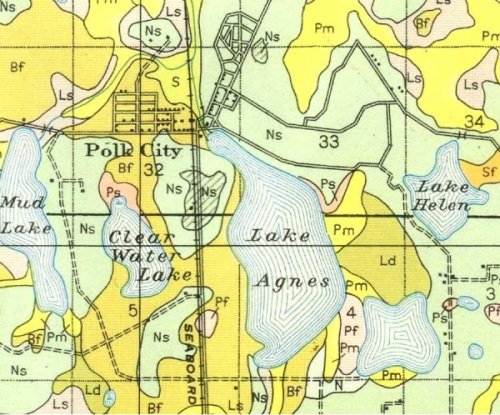Learn more about the Gateway to the Green Swamp
The City of Polk City, like all of America’s cities and towns, had a humble beginning. During the 1800’s farmers began to clear and farm the land. Naturally there was no power supply (other than horse or mule power) and water came from shallow wells which were dug by hand. Going into town was an ordeal as the shops and other stores of the day were far off and travel was on horseback or by buggy. The town was not even a town, just a grouping of farms.
Things started to change for what would become Polk City when a Mr. Isaac Van Horn was traveling through Polk County during the summer of 1922. Summers being what they are in Florida it was hot and humid. Taking a break to cool off along his trip by what is now known as Lake Agnes he observed the area’s natural beauty. The gently rolling hills, the breeze through trees was not completely unfamiliar to this Bostonian much of it reminded him of his home. It was here that Polk City was conceived in Mr. Van Horn’s mind.
Mr. Van Horn’s profession as a developer and as an investor provided him with sential financial connections in New Jersey and New York. As the chairman of the “Standing Committee of the Florida State Chamber of Commerce” he had played a part in developing the City of Haines City. This gave him insight into what a great place this area would be for a town.
Just north of where the present Polk City is today, Mr. Van Horn believed oil fields waited to be exploited. This belief caused him to bring in an oil drilling company and begin drilling well heads. Naturally, men and their families came for the jobs and the area began to become a beehive of activity. With the influx of people he realized that there was a need for a town closer than the nearest town which was 14 miles away. This may not seem like a great distance today, but a trip by horse and buggy of 14 miles could be a significant trip.
His belief in the area led Mr. Van Horn to purchase two square miles of land in what is now the center of Polk City. The land was cleared and the area began to expand. By the middle of 1925 Polk City had become a busy little place. The increasing population and new construction led to the incorporation of the town of Polk City on April 3, 1925. Mr. Van Horn was responsible for naming the town.

Polk City, Florida – 1925
Also in 1925, the Van Horn Building was completed. This building acted as the main offices for the Haynes-Van Horn Company, Polk City Country Club, Polk City Chamber of Commerce, the Polk City Chronicle, the Polk City Mortgage and Finance Center (which never opened), and the Town Hall with the Post Office located alongside. Where the present day Polk City Elementary School parking lot is today there was a large general store which had the imaginative name “The Store.”
Other City Improvements included the “Wayside Lodge” which opened to the public on the January 24, 1926. A school was built in town with four classrooms which housed student beginners through the eighth grade. This first school year opened with 64 students enrolled. The student body increased steadily throughout the year until by the close of that first year there were 90 students.
Progress always follows growth so water pipes and power lines became available and Polk City began becoming what we consider a modern town. The light poles of early electrical installations were much shorter than the poles of today so wires hung closer to the ground. These poles were constructed differently than they are today being made out of cement instead of lumber.

Road Map – Polk City, Florida – 1927
Seven years after he began searching for oil Mr. Van Horn realized that there must not be any oil in Polk City. With this, the oil drilling rigs soon moved out and soon afterwards came the great financial crash which began on the October 19, 1929. The financial crash on Wall Street launched the United States and the World at large into what became known as the Great Depression. With no industry or oil wells to work on families began losing their property, their homes and everything they had worked so hard for. Between 1930 and 1960 Polk City saw its population diminish from 600 people to just 203. It was during this time that Mr. Van Horn moved from Polk City to Lakeland and then back north.
Following World War Two negotiations between Van Horn and Associates and Mrs. John R. Brandon of New Jersey began. The Town of Polk City was transferred to a municipal property in exchange for the bonds. This single action left Polk City free of all debts.
Once the town’s debt load was reduced the town began a slow but steady recovery until we find ourselves just past the millennium. The town has grown from its low population level of 203 in 1960 to reach the nearly 2,000 people today living within the city Limits. The population of those living within the 33868 zip code (both city and county residents) is 10,885.
The town of Polk City was changed by ordinance to the City of Polk City in 2005. Today, Polk City’s future looks bright with its continuing expansion and growth in the housing, commercial, and industrial markets.
